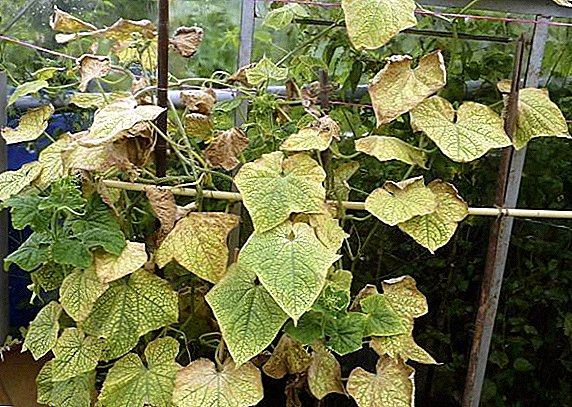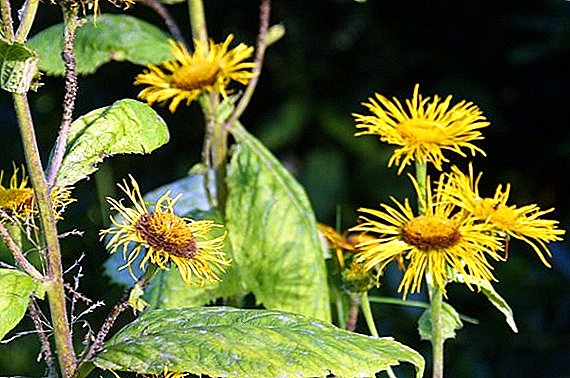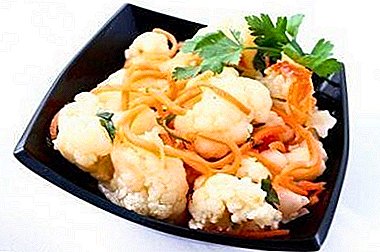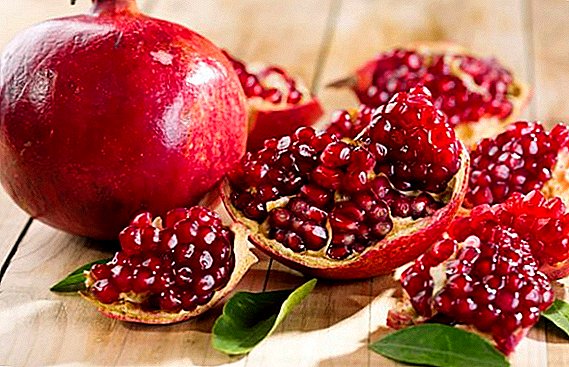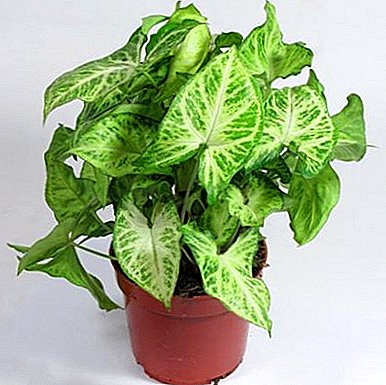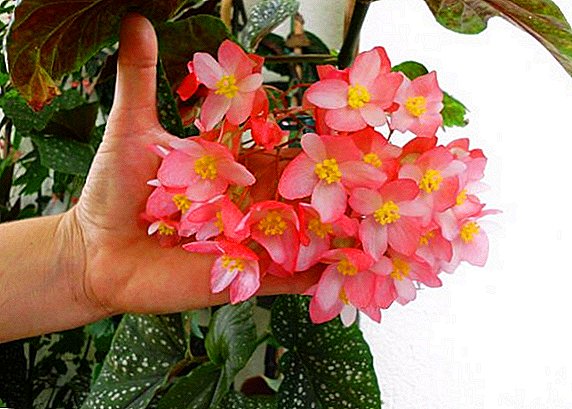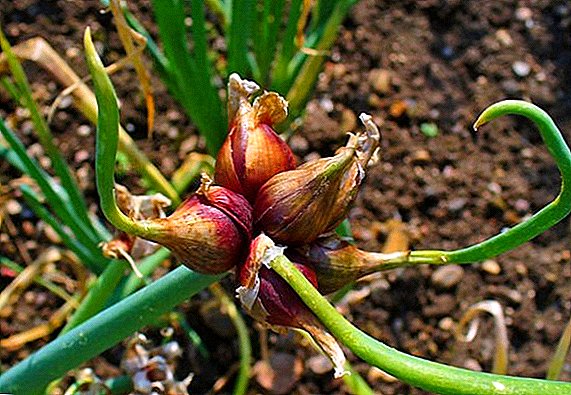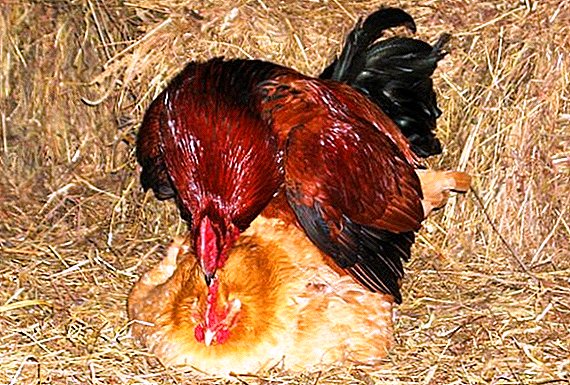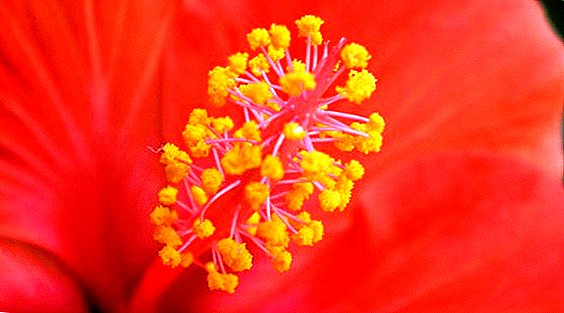 Hibiscus in all its diversity are represented throughout the world. These magnificent flowers from the common Malvova family in the wild and cultivated flora are found in the form of annual and perennial, evergreen and deciduous trees, shrubs, herbaceous and indoor plants.
Hibiscus in all its diversity are represented throughout the world. These magnificent flowers from the common Malvova family in the wild and cultivated flora are found in the form of annual and perennial, evergreen and deciduous trees, shrubs, herbaceous and indoor plants.
In the wet floodplain onions of Southeast Asia, where they come from, you can admire the continuous thickets of delicate buds with large petals. According to various sources, flowers of the hibiscus family have from 150 to 300 species. Sometimes they are mistakenly confused with Ukrainian malvies. Let's try to understand the features of the most common varieties.
Did you know? In many countries, hibiscus is not just a decoration. For example, young leaves and sprouts of some varieties are eaten as vegetables, seeds and roots of others are processed for the preparation of medicines, and black hair dye, crimson food colors and many favorite carcade tea are made from flowers.
Hibiscus hybrid (Hibiscus hybridus)
This perennial in our latitudes is very common, cultivated as a houseplant and garden plant. In warm countries, it can be found only as a grassy street decoration. The variety was obtained about 70 years ago by a Soviet botanist, Professor Fyodor Rusanov, who is the founder of the Tashkent Botanical Garden in Uzbekistan.  For the bred variety, the breeder successfully selected the parent material - hibiscus from North America: bright red (Hibiscus coccineus), marsh (Hibiscus moscheutos) and armed (Hibiscus militaris). From these grass cultures, hibiscus hybrid in the process of crossing inherited low temperature tolerance and large scarlet inflorescences, which in diameter reach from 18 to 25 cm.
For the bred variety, the breeder successfully selected the parent material - hibiscus from North America: bright red (Hibiscus coccineus), marsh (Hibiscus moscheutos) and armed (Hibiscus militaris). From these grass cultures, hibiscus hybrid in the process of crossing inherited low temperature tolerance and large scarlet inflorescences, which in diameter reach from 18 to 25 cm.
The buds open in August and delight the eye with subtle beauty before the first frost. For winter, only strong rhizomes remain alive in garden hibiscus, and the stems die off completely. Late in spring, they throw out scanty sprouts, similar to spears, stretching up to 2 meters and higher, and slowly take shelter of 3-5-lobed leaves.
Giant single flowers appear in the second year after disembarkation, there are simple and terry. In color, they are also different - from pure white to blood red. Faded inflorescences turn into green seed boxes, which, when ripe, take on a brown color and dry out.
Caring for representatives of this type does not require additional efforts and knowledge, it is available even for beginners. When planting, it is desirable to place the plant in a sunny area, protecting it from the northern winds and shade. The soil will suit any, of course, more comfortable hybrid hibiscus will be in enriched and well-drained black soil.  The flower tends to tolerate moderate drought and frost. For the root system to safely winter, it is covered for the winter with mulch or dry leaves. This type of hibiscus propagates by dividing rhizome, grafting and grafting.
The flower tends to tolerate moderate drought and frost. For the root system to safely winter, it is covered for the winter with mulch or dry leaves. This type of hibiscus propagates by dividing rhizome, grafting and grafting.
Important! Dark scarlet spots on the leaves indicate excessive feeding and a simultaneous lack of light.Indoor specimens like well-lit places, but are burned in direct sunlight. The western and eastern sides are more suitable for the flowerpots. In the summer, the pot is carried out outside, protecting it from drafts and rain. With the reduction of daylight there is a need for additional artificial lighting. Otherwise, the inflorescences can not wait.
It is characteristic that at home hybrid hibiscus during the growing season contain at a temperature of +20 ° C, and in the autumn-winter time they are accustomed to +16 ° C. If you continue to reduce the temperature, the flower can lose foliage. By the way, this is a great reason to do it. trimming. It is necessary for the formation of the crown and rejuvenation of the flower. For this purpose, they cut the sprouts at the level of 8-15 cm from the ground.  Competent pruning is always carried out after repotting the pot or changing the soil in the pot. If you then put the container in a cool place and rarely watered, the culture will hibernate for several months. When new shoots appear, watering and spraying increase and occasionally pinch off the shoots for better branching.
Competent pruning is always carried out after repotting the pot or changing the soil in the pot. If you then put the container in a cool place and rarely watered, the culture will hibernate for several months. When new shoots appear, watering and spraying increase and occasionally pinch off the shoots for better branching.
Chinese rose (Hibiscus rosa-sinensis)
In the wild, this hibiscus variety can be seen on the native islands of the Pacific tropics and in East Asia. The inhabitants of the temperate climatic zone of the Northern Hemisphere are well-known in China as indoor culture, and in the subtropics it is cultivated to decorate gardens and greenhouses. Also called a flower rosanel.  An evergreen plant can develop in the form of a bush or a small tree, extending up to 4 meters. On the powerful branches of the bark becomes brown and green on the young. The leaves are large, oval-shaped, sharp at the edges with a glossy surface and light inner roughness.
An evergreen plant can develop in the form of a bush or a small tree, extending up to 4 meters. On the powerful branches of the bark becomes brown and green on the young. The leaves are large, oval-shaped, sharp at the edges with a glossy surface and light inner roughness.
Hibiscus roses reach a diameter of 10-15 cm. More often, these are simple single flowers with a tall pedicle, a funnel-shaped calyx of the bell-shaped form and long pistil threads that, when grown together, go far beyond the petals. Flowering lasts only a couple of days, but due to the appearance of new buds, hibiscus continuously pleases with roses from early spring to late autumn.
Did you know? Chinese rose can often be found in administrative premises. Houses are afraid to grow a flower because of the many superstitions associated with it. A bad sign is the sudden flowering and falling foliage. It is said that it is unfortunate, illnesses and quarrels in the family..Simple red flowers are the most common, but in the last two decades, breeders have developed many terry species of various shapes and colors: from pale orange to deep purple. Also, low-growing species of Dutch origin and hibiscus with variegated leaves of bright scarlet color with white splashes appeared.
 Chinese hibiscus are propagated mainly cutting method.
Chinese hibiscus are propagated mainly cutting method.Special care for the variety is required at a young age and during the flowering period. Mistakes are made by the absence of flowers and plant diseases. For a lush flowering crown, after rooting, they pinch off the top of the seedling, and with the appearance of buds every day in the morning and in the evening, they water and sprinkle the pot, monitor sufficient lighting and feed them. In the future, as far as necessary, it will be necessary to shear weak branches and form a crown.
Very useful for Chinese roses are mixtures of phosphate, potash and nitrogen fertilizers. A liquid top dressing is poured monthly under the roots and into a spray bottle for spraying. It is important that the solution does not fall on the flowers.
Blackening on the leaves and wilting buds - obvious signs of infectious diseases that are the result of improper care. Culture is very sensitive to spider mites, felts, thrips, whiteflies and fungi. For prophylaxis, it is recommended not to dry out and not to overwet the soil, to protect the flower from drafts, sudden changes in temperature. In addition, once a month to process the plant with toxic chemicals.  Unlike superstitious housewives, botanists find explanations for the absence and sudden appearance of flowers, yellowing, falling foliage. Scientists completely dispel the myth that hibiscus flowers are a sign of illness and death, paying attention to gardeners to the need to cut the crown of the Chinese rose (otherwise the full potential of the plant will go to the growth of branches, and there will be no strength left to bloom). With proper care, the Chinese rose can live to 20 years and annually produce spectacular beautiful roses.
Unlike superstitious housewives, botanists find explanations for the absence and sudden appearance of flowers, yellowing, falling foliage. Scientists completely dispel the myth that hibiscus flowers are a sign of illness and death, paying attention to gardeners to the need to cut the crown of the Chinese rose (otherwise the full potential of the plant will go to the growth of branches, and there will be no strength left to bloom). With proper care, the Chinese rose can live to 20 years and annually produce spectacular beautiful roses.
Important! Indoor and garden hibiscus suffer from leaf chlorosis, which is accompanied by their fall. The cause is an excessive amount of chlorine and calcium in the water for irrigation and a lack of nitrogen and iron. In order to prevent illness, make sure that the water, which you are going to water the plant with, is well settled. Top dressing is also desirable.
Marsh Hibiscus (Hibiscus moscheutos)
The herbaceous perennial is popular in the beds of subtropical latitudes. Ukrainian flower growers cultivate it in open ground, rarely - in room conditions. The people of this type of hibiscus bush is also called "swamp".  It received its name due to two important requirements in the care: For the full development of the shrub needs water and a sunny lawn. Very comfortable conditions will create close to him the current stream or pond.
It received its name due to two important requirements in the care: For the full development of the shrub needs water and a sunny lawn. Very comfortable conditions will create close to him the current stream or pond.
Despite the unattractive name, the variety attracts gardeners with elegant flowers of various colors with exquisite corollas and bright spots-strokes. The flowering period begins at the beginning of summer and ends in autumn. Each flower in diameter reaches from 12 to 16 cm. In place of the faded cups, seed boxes with glossy grains ripen.
The leaves are large, slightly convex, rich green color, which persists until frost. Frost-resistant plant, like a hybrid hibiscus, in the presence of snow cover can survive 25 degrees of frost. At the end of winter or in spring (before the juice begins to flow and buds begin to move) crown formation. It also removes old, diseased and damaged branches. The marsh mallow retains its shape throughout the year.
In favorable conditions, the bush grows up to 3 meters in height and up to 18 meters in width. Based on these features, it is used as a decorated hedge. Moreover, the culture can live to 23 years and is not picky at all in care.  Having provided her with a lot of sun and constantly wet, slightly acidic soil during planting, you can count on a lush and long flowering. In the shadow of the swamp hibiscus will bloom badly, actively increasing green biomass.
Having provided her with a lot of sun and constantly wet, slightly acidic soil during planting, you can count on a lush and long flowering. In the shadow of the swamp hibiscus will bloom badly, actively increasing green biomass.
Important! For rooting hibiscus cutting method cuttings with three buds, and then treated with "root" and deepen into a wet mixture of peat and sand. A month later, there are roots.A characteristic feature of swamp hibiscus is the lack of response to the lack of fertilizers. At the same time, their search will immediately affect the decorative effect. The most suitable for the bush is considered to be any organic matter (introduced in spring) and phosphorus-potassium mixtures (introduced in autumn). Traditional care, like any hibiscus, is compulsory watering, loosening the soil and removing weeds.
Syriac hibiscus (Hibiscus syriacus)
The varieties of Syrian hibiscus are the most common in the post-Soviet territory. They are a fairly high shrub, from 3 to 6 meters high, with smooth branches, bright green oval-shaped leaves and large single flowers of different shades of scarlet and purple spectrum, which are simple and terry. And also there are two-colored copies.  The peculiarity of the variety is in the slow development of the shrub. The intensity of its growth will accelerate moderate systematic watering. Do not overfill or overdry. When the drought culture throws flowers, so in hot weather, you may need daily watering.
The peculiarity of the variety is in the slow development of the shrub. The intensity of its growth will accelerate moderate systematic watering. Do not overfill or overdry. When the drought culture throws flowers, so in hot weather, you may need daily watering.
In the blooming phase, the Syrian hibiscus enters the 3-4th year of life, begins in May and fades in November. The diameter of the flowers is about 12 cm on average. It is characteristic that the pedicel fades on the day of flowering, but this fact is due to the multitude of buds imperceptible.
The best place for a plant will be a sunny plot with well drained loamy soil. Does not like limestone. It responds well to pruning, which is to remove old and cut off too long branches. Propagated by cuttings, layering, seed and graft.
Young saplings are very sensitive to a decrease in temperature, so for the winter their root system is being spudded with dry leaves or fresh sawdust. If the hibiscus is still affected by frost, in the spring new shoots will appear on it.
Do not rush to conclusions about the dying off of its roots, because the lingering signs of life on the bush appear late in the spring. His endurance to cold develops to the extent of growth. Older specimens can successfully winter at 22 ° C frost. More resistant in this aspect terry species.  For better wintering in the fall, the plant is fed with potassium. And for the intensity of growth and strengthening of the root system, pour liquid infusion of chicken manure. Alternatively, phosphate fertilizers can be used.
For better wintering in the fall, the plant is fed with potassium. And for the intensity of growth and strengthening of the root system, pour liquid infusion of chicken manure. Alternatively, phosphate fertilizers can be used.
Did you know? In South Korea, are very sensitive to the Syrian hibiscus. The plant is considered national and believe that it accompanies happiness and love.In landscape design, Syriac hibiscus is used as a single plant and in compositions, it is given standard and truncated forms, planted in containers. The plant is perfectly combined with lavender, which, in addition to the beautiful decorative pictures, drives away pests from the shrub.
When buying a young seedling, preference should be given to specimens with well-grown roots and a strong trunk. The shrub can be propagated by seed and cuttings.
Hibiscus Sour (Hibiscus acetosella)
In the wild, this species is found in the tropics of Africa, for which it is called in informal circles "African Mallow". And there are names red leaf carcade, "maple leaf". And all because of the crimson color of maple-like foliage, giving hibiscus indescribable beauty and uniqueness. At home, young shoots of culture are widely consumed in food. They taste sourish, reminiscent of sorrel.  The cultivated version opened the French. It is assumed that the variety of hibiscus sour in the process of hybridization inherited biological features from the species Hibiscus asper and Hibiscus surattensis. Today it is represented by a rich variety of forms.
The cultivated version opened the French. It is assumed that the variety of hibiscus sour in the process of hybridization inherited biological features from the species Hibiscus asper and Hibiscus surattensis. Today it is represented by a rich variety of forms.
Externally, this luxurious perennial shrub perennial, popular in tropical and subtropical climates of all continents. May survive mild winters with frost not more than 8 degrees. In temperate zones is cultivated as an annual plant. It is characterized by a dense crown, which extends up to a maximum of 1.5 m and expands in breadth to 80 cm.
Stems are elastic, straight, covered with light down. The leaves are large, as already mentioned, pentagonal with a smooth surface, on which are distinct veins, and an unusual motley coloring. In some species, it acquires a greenish, purple or purple shades.
Hibiscus flowers compared with the above varieties are small, reach a diameter of 5-10 cm, appear in the upper part of the stems from the axillary leaves. There are different colors.
A typical sign of the variety is the harmonious combination of the vein on the foliage with the color of the petals. The exoticity of the buds is complemented by a long, over 2 cm stamen extending beyond the flower. On the faded pedicels the seed ripens, very reminiscent of chestnuts.
Did you know? In the Congo and Cameroon, sour hibiscus is sold on the markets in bunches for salads. And in Brazil, culture is grown as spinach and the foliage is very much appreciated for vitamins C, A, group B, iron trace elements and antioxidants. Also noted fleshyness in the structure and the property not to lose color and taste during heat treatment. The Angolan people hibiscus raises hemoglobin in the blood. And in Central America, it is used to make thirst-quenching burgundy lemonade, which is drunk with lemon and ice. From the flowers brew tea. African people mistakenly call it hibiscus, although, in fact, the real hibiscus is made from flower cups of Sudanese hibiscus.
 Today in the flower market, hibiscus is sour in various forms. The most common: Red Shield, Panama Red, Panama Bronze, Garden Leader Gro Big Red, Jungle Red. Most of them are low-flowering, thermophilic varieties that have been recognized for their unique foliage.
Today in the flower market, hibiscus is sour in various forms. The most common: Red Shield, Panama Red, Panama Bronze, Garden Leader Gro Big Red, Jungle Red. Most of them are low-flowering, thermophilic varieties that have been recognized for their unique foliage.As annuals, they adapt well in our latitudes, like moist, well-translucent, slightly acidic soils in sunny areas. Tender stalks are afraid of strong winds. Flowering begins in August and lasts a couple of weeks, but the whole summer and part of the autumn the plant flaunts extravagant variegated foliage. In the winter, the roots are dug up and transplanted into a pot. The advantage of the species is resistance to nematodes. This quality is used by breeders when crossing to obtain new breeds.
Hibiscus Arnotti (Hibiscus arnottianus)
Globally, this species is known on all continents due to its healing properties. The leaves, flowers and bark of the shrub are used to prepare laxative decoctions and to clean the blood. From the Hawaiian Islands, where Arnotti is the birthplace of evergreen hibiscus, it has spread far beyond the tropics and subtropics. In temperate climates, it is cultivated as an annual plant.  Among other species of the family, it is distinguished by tall, straight stems, which sometimes reach 10 m, and fragrant tubular flowers with multi-colored "eyes". The diameter of the flower is over 10 cm. The petals are mostly white with delicate scarlet or purple veins in tune with the pistil rising above the bud.
Among other species of the family, it is distinguished by tall, straight stems, which sometimes reach 10 m, and fragrant tubular flowers with multi-colored "eyes". The diameter of the flower is over 10 cm. The petals are mostly white with delicate scarlet or purple veins in tune with the pistil rising above the bud.
In native latitudes, the plant grew among forest trees with a height of over 30 m. Obviously, it is necessary to create as close as possible conditions in the shrub garden. Для полноценного развития ему достаточно тепла и влаги. Комфорт обеспечит дренированный чернозем. Время от времени его необходимо обогащать органикой и минеральными комплексными удобрениями.
На зиму корни пересаживают для содержания в комнатных условиях. Некоторые садоводы для избегания лишних хлопот выращивают сорта этого вида в больших емкостях. Летом их выносят на улицу, а зимовать забирают в дом.
Shrubs are propagated exclusively rooting cuttings, because in our latitudes seeds almost never ripen.
Did you know? In Hawaii, hibiscus is called the "flower of beautiful women" and is considered a national culture.Some subspecies of the hibiscus Arnotti are recognized as endangered. For example, immaculatus suffers from eating wild animals. Its representatives are rarely found on 2-3 Malay Islands around the globe.
Hawaiian Hibiscus (Hibiscus clayi)
Among Ukrainian flower growers, Hawaiian hibiscus is known as a house tree-like plant, and in warm countries it is used for outdoor gardening. The stalks of the bush grow to the level of 30-50 cm. Leaves with a glossy surface, slightly oblong, slightly arched, resemble a dwarf ficus. Flowers consist of five red petals, folded in a long green cup.  Homeland culture are forests on the Hawaiian island of Nunu. With the development of civilization in the wild, the species has hardly survived. It is cut down, expanding resort areas, highways and cities, and in rural areas animals cause irreparable damage for which it is only food.
Homeland culture are forests on the Hawaiian island of Nunu. With the development of civilization in the wild, the species has hardly survived. It is cut down, expanding resort areas, highways and cities, and in rural areas animals cause irreparable damage for which it is only food.
Little is known about Hawaiian hibiscus. In botanical encyclopedias, the general features of the species are very succinctly stated, without mentioning the history of occurrence, flowering cycles, longevity, the main requirements for full-fledged development, and growth inhibiting factors.
Flower growers in their comments on the culture mention the vital conditions for it:
- diffused light;
- temperature range from 18 to 22 ° C - in the hot season and from 16 to 18 ° C - in the cold;
- soil and air humidity, which requires systematic watering and spraying;
- monthly one-time top dressing with nitrogen fertilizers;
- light turf soil mixed with sand and humus, high-quality drainage.
Hibiscus splayed (Hibiscus divaricatus)
At its core, this type of hibiscus has collected Australian varieties - analogues of the Chinese rose. Externally splayed hibiscus is an evergreen shrub with thorny stems. It has a strong trunk with uneven bark, low-lying branches and large leaves, round shape up to 10 cm in diameter. Flowers are yellow with a raspberry base. On the calyx, and then on the pod with the kernels, hard villi are visible, similar to the prickles. 
Important! All room hibiscus every three years in need of a transplant. Young specimens are best transplanted annually.Domestic varieties reach a height of three meters, and on the native coasts and forest edges of Australia, where the hibiscus is spread, comes over 5 meters. Obviously, it got its name because of the awkward shape of the crown: the branches first leave the trunk rush up.
Florists are attracted to a greater extent exotic inflorescences. Each flower is about 10 cm in diameter, pollinated by insects. But the seeds of a shrub rarely bred, preferring the way grafting. Young seedlings require special care, and mature plants are very patient.
Hibiscus raznolistovy (Hibiscus diversifolius)
His homeland is the Australian lands of Botany Bay in New South Wales and the Pacific Islands. Also found in Africa, Mauritius, Madagascar. In our latitudes, cultivated as a pot plant. Some lovers of room flora are often confused raznolistkovy and splayed hibiscus.  Besides origin, they have a lot in common: of equal length, similar in appearance to the stems, large flowers with a long pestle, petiole method of reproduction. Difference raznoliskovogo species are leaves, resembling a heart shape up to 10 cm in diameter, with irregular sections along the edges. On the stems a lot of thorns.
Besides origin, they have a lot in common: of equal length, similar in appearance to the stems, large flowers with a long pestle, petiole method of reproduction. Difference raznoliskovogo species are leaves, resembling a heart shape up to 10 cm in diameter, with irregular sections along the edges. On the stems a lot of thorns.
The diversity of the species is due to ragged irregular serration and the presence of leaves of different sections on one stem. Near the tops, they can be solid, and going down, split into 3 or 5 segments. On the inside, each leaf is thickly covered with nap, which makes it rough.
Buds of pale yellow color with a rich purple center are collected in inflorescences, which are directed downwards. Cups bright green with a bristly pile.
In addition to heat and sun, hibiscus of this species adore water. In their native environment they inhabit the shores of reservoirs, wet fields and the outskirts of swamps. At home, in need of frequent watering and pruning crown. The peculiarity of diversifolius is in endurance to mild winters.
Hibiscus Drummond (Hibiscus drummondii)
It is a shrub up to 2 m tall with thin branches directed upwards. The leaves are tripartite, up to 5 cm long, with rough teeth along the edges. Tubular flowers of 5 petals, scarlet and purple color, which flows from the more saturated in the center to the delicate at the edges.  Title "sleepy hibiscus" due to incomplete openness of the buds. They seemed to be ready to blossom and stopped waiting for the right moment. In diameter, variegated roses reach 11 cm.
Title "sleepy hibiscus" due to incomplete openness of the buds. They seemed to be ready to blossom and stopped waiting for the right moment. In diameter, variegated roses reach 11 cm.
On the Australian coasts, where Drummond's hibiscus hails from, the buds fill with a light pearl tint. From a distance, at the sight of a flowering shrub, it seems as if someone had painted purple crimped paper with a mother-of-pearl brush and hung it on the green crown of the bush.
For regular lush flowering culture needs diffused light and moisture. In native shady areas in dry forest areas, the hibiscus does not produce flowers, directing the branches higher and higher towards the sun. In this case, the shrub grows very much, intertwining with other plants, forms a green wall.
Important! If a mature home or garden hibiscus does not bloom, it is worthwhile to reduce the amount of nitrogen fertilizer, which provokes an increase in green biomass. Also, the reason may lie in the lack of water, light, or in too high a temperature during hibernation.
Hibiscus high (Hibiscus elatus)
The plant, which has spread throughout the world from Jamaica, is characterized by high ornamental colors and quality wood. It is these two features that explain the parallel Caribbean name of hibiscus high - "blue macho"that means blue polish.  In its natural form, the culture is found in the southwestern part of India, cultivated evergreen trees adorn the streets in countries of warm latitudes. They are difficult not to notice, even when the buds have not yet been opened. The fact is that the straight trunks of these trees are very tall.
In its natural form, the culture is found in the southwestern part of India, cultivated evergreen trees adorn the streets in countries of warm latitudes. They are difficult not to notice, even when the buds have not yet been opened. The fact is that the straight trunks of these trees are very tall.
They develop sky high quickly and reach 25-30 meters. In temperate climates, the maximum height of hibiscus is within 7 meters, and in regions with high humidity and a warm climate, the culture can stun with a kilometer height.
Branched crown is rounded in shape, with wide oval leaves up to 20 cm long. The trunk is powerful with fibrous bark. The tubular flowers of 5 petals amaze with their variegation: the buds are yellow in color, and to the extent of disclosure, their color flows into a rich orange, then red. Roses reach a diameter of 12 cm, their edges are slightly folded to the cup. In some varieties, yellow-crimson stripes on the orange body persist throughout the flowering.  At home, the culture is used to restore forests and is considered a valuable breed. The aesthetics, durability and magnificent texture of hibiscus high wood have to be used in the manufacture of furniture, frames for paintings and other items of interior decor. And also it is indispensable in the manufacture of musical instruments Katros, something like a lute. Cuban bast plants are used in boxes for cigarette cases.
At home, the culture is used to restore forests and is considered a valuable breed. The aesthetics, durability and magnificent texture of hibiscus high wood have to be used in the manufacture of furniture, frames for paintings and other items of interior decor. And also it is indispensable in the manufacture of musical instruments Katros, something like a lute. Cuban bast plants are used in boxes for cigarette cases.
Hibiscus edible, or okra (Hibiscus esculentus)
This beautiful hibiscus species in English speaking countries is known as lady's fingerthat translated means female fingers. Also called okro and gombo. In the UK, the USA and the Philippines - okra.
The geographical origin of the edible hibiscus species is not precisely known. Assigning it to himself, botanists of South Asia and West Africa are still arguing on this topic. Culture is widely grown throughout the world in tropical, subtropical and moderately warm latitudes, valued by the nutritional composition of young pods. 
Did you know? In 1216, the Spaniards visited Egypt. They loved the treats of cooked green seed pods. After returning home, they told about the unique culture that Africans grow. In 1658 it appeared in Brazil, and in 1748 in distant Philadelphia. For the first time about the breeding of new varieties of the species started talking in 1806.In our latitudes, perennial cultivated as an annual herb. Externally, okra is a shrub up to two meters tall. Recently, breeders have offered dwarf varieties no higher than 50 cm. Thick stalks are densely branched, slightly pubescent.
In adulthood, the trunk of wood. The leaves are huge, up to 20 cm long, with 5-7 lobes, covered with a weak pile, bright shades of green. Flowers of medium size - up to 8 cm, with 5 petals of white, yellow color with red, purple "eyes" at the base. Fruits form in leafy sinuses, resemble a capsule up to 18 cm in length with a transverse pentagonal section. It contains round grains.
The food consumed young ovary, which is not more than 3 days. Older, brown in color, are considered unsuitable due to bad taste. Okra is eaten raw, roasted, stewed, boiled, and it is also suitable for freezing and home canning.
The chemical composition of 100 g of okra is 7.45 g of carbohydrates, 0.19 g of fat, 1.9 g of proteins, 3.2 g of dietary fiber, 89.6 g of water. And also vitamins: A - 5%, C - 28%, E - 2%, K - 30%, thiamine (B1) - 17%, riboflavin (B2) - 5%, niacin (B3) - 7%, folic acid (B9) - 15%, potassium - 8%, calcium - 6%, zinc - 6%, phosphorus - 9%, iron - 5%, magnesium - 16%.  In the process of cooking edible hibiscus turns into a slimy mass. The plant in its original form is red and green. In taste they are the same. During heat treatments, the red look turns green. Suitable for use and foliage. Oil squeezed from okra seeds is highly valued in the global market. It was learned to use it not only for culinary and cosmetic purposes, but even as a fuel.
In the process of cooking edible hibiscus turns into a slimy mass. The plant in its original form is red and green. In taste they are the same. During heat treatments, the red look turns green. Suitable for use and foliage. Oil squeezed from okra seeds is highly valued in the global market. It was learned to use it not only for culinary and cosmetic purposes, but even as a fuel.
With immature pods, soup and stew are cooked, and ripe specimens are fried and the famous gombo coffee is prepared. Drink is allowed, even for children, because it does not contain caffeine. In some countries, the species is cultivated solely for the production of fruits in which a high content of starchy substance called hombin.
It is processed into powder, which is widely used by local chefs as a thickener for soups and creams. In addition, cough preparations are made from the plant to restore immunity and to treat the digestive tract.
The collection of fruits must be carried out in gloves, because the stiff, fuzzy structure of the stems provokes irritation of the skin. 
Did you know? When the first fruit ripens on okra, the development of other flowers and pods slows down. If the ovaries regularly pinch off, they will be formed before the appearance of the fruit.In the care culture is not demanding. Loves heat and the sun, it is considered the most heat-resistant of all malvovyh. It is cultivated even on dry clay soils. The drought is not terrible, unlike frost. It can tolerate short-term frosts up to 3 degrees, but will reduce the rate of growth.
The heat-loving plant is planted by seed in an open ground only in warm countries. In our latitudes, gardeners practice planting hibiscus seedlings in greenhouses. After germination and strengthening of germs, seedlings are planted in pots and subsequently grown as a houseplant. In the summer, the container is put into the garden, saving it from drafts and rain.
Plant threatened powdery mildew, gall nematodes and verticillary wilt. With the preventive purpose, the culture is periodically treated with pesticides.
Hibiscus fragile (Hibiscus fragilis)
View of extremely rare endemic shrubs growing on the steep slopes of the Cordegardia Mountains, Le Morne Brabant in Mauritius. Externally, hibiscus is fragile like a Chinese rose.
Perennial is an evergreen very dense shrub with a widely branched crown. Leaves 5-7-segment. The flowers are tubular, with 5 petals that find on each other, bright scarlet, terracotta and red shades. There are up to 10 cm in diameter.  Hibiscus brittle in the wild disappears. Today, it is estimated at only four dozen copies and cannot independently recover to old quantities. According to scientists, the blame for this is an active competing hybridization. The staff of the Royal Botanic Gardens at Kew are trying to solve the problem by reproducing culture seedlings. Successes in cultivation instill hopes for the return of the species in the natural environment.
Hibiscus brittle in the wild disappears. Today, it is estimated at only four dozen copies and cannot independently recover to old quantities. According to scientists, the blame for this is an active competing hybridization. The staff of the Royal Botanic Gardens at Kew are trying to solve the problem by reproducing culture seedlings. Successes in cultivation instill hopes for the return of the species in the natural environment.
Mixed Hibiscus (Hibiscus heterophyllus)
The perennial plant is common in New South Wales and Queensland, in Australia. It is a tall, fast-growing shrub or tree with white, delicate scarlet flowers and edible fruits.  In its native environment, the hibiscus of diverse leaves prefers warm and humid conditions. The period of flowering and the color of the petals depend on the habitat. For example, specimens in northern Queensland bloom in June with bright yellow roses, while those closer to southern latitudes bloom with white buds in December.
In its native environment, the hibiscus of diverse leaves prefers warm and humid conditions. The period of flowering and the color of the petals depend on the habitat. For example, specimens in northern Queensland bloom in June with bright yellow roses, while those closer to southern latitudes bloom with white buds in December.
In the native environment, the evergreen shrub grows up to 6 m, and in areas with a temperate climate, its maximum height is up to 2 m. To maintain a neat look of a widely branched crown, periodically pruned branches. The best period for this procedure, gardeners consider the phase after flowering. Then you need a third to pinch off the top.
Vital to the development of hibiscus are scattered light, moisture and heat. The plant can tolerate a temporary decrease in temperature, but it will appear on its flowering. Dislikes northern winds and rains.
It is better to place the pot in the room away from direct sunlight, and in the summer, when carrying it out to the garden, hide in protected partial shade. When grown in open ground, the best place for this specimen will be near the wall or fence.  Hibiscus multiply cuttings or seeds. Depending on the method chosen, the stems will form. That is, if you root the stalk, in the future you will get fibrous roots, which contribute to abundant and long-term flowering. In cases with grains, the core will grow, and consequently, there will be few flowers and they will appear late.
Hibiscus multiply cuttings or seeds. Depending on the method chosen, the stems will form. That is, if you root the stalk, in the future you will get fibrous roots, which contribute to abundant and long-term flowering. In cases with grains, the core will grow, and consequently, there will be few flowers and they will appear late.
Important! For reproduction of hibiscus by cutting, at the end of winter, in a healthy specimen, the upper part of the branch is cut at an angle through the knot and left for 6-8 weeks until the roots appear in the container with water. After that they are planted in a substrate of humus, peat and leafy ground.
Hyugel Hibiscus (Hibiscus huegelii)
It is one of 35 Australian Hibiscus. The sandy coasts of Western Australia are his native environment. Among its fellow plant is distinguished by large flowers, which vary greatly in color. In Europe, it is called "hibiscus lilac". The name is caused by the color of the buds.
The official name of the species was in honor of Baron von Hughel. Scientists are still debating about the classification of the species. In encyclopedic literature varieties hibiscus huegelii leptochlamys (purple) and hibiscus huegelii wrayae (white)no longer considered as a subspecies of cultivated varieties.  Outwardly, it is tall, up to 4 meters, a well-branched shrub, with bright green fuzzy leaves, divided into 3-5 segments. Their edges are serrated, the inner side is pubescent, and the veins are well visible on the outer side. Buds consist of 5 petals, up to 7 cm long, the edges of which are found on each other. More common are purple, lilac, blue, red, cream shades.
Outwardly, it is tall, up to 4 meters, a well-branched shrub, with bright green fuzzy leaves, divided into 3-5 segments. Their edges are serrated, the inner side is pubescent, and the veins are well visible on the outer side. Buds consist of 5 petals, up to 7 cm long, the edges of which are found on each other. More common are purple, lilac, blue, red, cream shades.
By the end of the day, as with all malvaceae, the flowers are picking up bright colors and fade, resembling paper in structure. In the wild, flowering lasts from June to January, and in the cultivated environment - until the temperature drops.
The plant is absolutely not demanding on the soil. Loves clay, sandy, well-lit, drained areas and moisture. Does not tolerate low temperatures. In order to maintain vitality it needs additional feeding. After flowering, the bush is cut for compact crown. The peculiarity of the species is the rare foliage on the lower branches and fast-growing young shoots that come close to the cuts.
Hibiscus kahili (Hibiscus kahilii)
Distributed on the Australian shores. In our latitudes, cultivated in the open ground as an annual and as a pot plant.
Outwardly, it is a medium-sized bush with straight, powerful stems extending upwards and in breadth to 1-2 meters. The leaves are large, up to 8 cm long, covered with a light pile, bright green color, with 3-5 segments.  It blooms from late May to September. The buds are tubular, single, with 5 petals, with a diameter of up to 10 cm. Their color is often scarlet, red, purple. Characteristically, the flowers are not fully disclosed, which is similar to the Drummond hibiscus.
It blooms from late May to September. The buds are tubular, single, with 5 petals, with a diameter of up to 10 cm. Their color is often scarlet, red, purple. Characteristically, the flowers are not fully disclosed, which is similar to the Drummond hibiscus.
Representatives of this species love light, although they can develop in partial shade. It is also important soil moisture and air, twice feeding (preferably in spring and summer) and timely pruning.
Important! Для размножения гибискусов семенным способом, спелые зерна сначала заливают на сутки теплой водой, после чего высевают в емкость с влажным субстратом и отправляют в теплое место до появления всходов.
Гибискус изменчивый (Hibiscus mutabilis)
Так растение называют из-за свойства цветов менять окрас лепестков по мере созревания. Помимо того, на родине, в Китае, гибискус прозвали "лотосовым деревом", а в Буэнос-Айресе - "бешеной розой".
Culture is widely known on all continents in tropical, subtropical and temperate latitudes, cultivated as a street, garden decoration and pot plant. The Chinese believe in the healing properties of hibiscus, so for them it is not just a beautiful flower, but also a means to alleviate pain.  In the wild, the hibiscus is changeable - an evergreen shrub, and in countries with cold winters - carrionous. It has powerful stems up to 3 m high. Krona is umbrella-shaped. The leaves are jagged, maple, saturated green color, with a slight hairiness. Their length reaches 25 cm.
In the wild, the hibiscus is changeable - an evergreen shrub, and in countries with cold winters - carrionous. It has powerful stems up to 3 m high. Krona is umbrella-shaped. The leaves are jagged, maple, saturated green color, with a slight hairiness. Their length reaches 25 cm.
Terry flowers, large sizes, unlike other types of hibiscus, do not bloom on the day of bud opening. Moreover, they are amazing with the color of the petals, which change three times during the flowering period. Initially, the buds are creamy, on the second day the opened rose is white, tomorrow it will become soft scarlet, and the day after tomorrow - purple. The flowering period begins in July and lasts until September.
In room conditions, the pot is better placed on the southern and eastern sides, since it will die in the shade. In the summer it can be taken out to the garden, and in the winter it can be kept at a reduced temperature (up to 15 ° С). Also, to the extent of reducing daylight, additional lighting will be needed. Pruning representatives of this type of hibiscus spend every season, pinching off the apical points of growth. Strongly overgrown shrubs are cut without sparing - soon they will release arrows of new shoots.
The soil for the culture is chosen slightly acidic, it must be sufficiently moist and drained.
Pandurovid hibiscus (Hibiscus panduriformis)
Hibiscus pandurovidny represents evergreen perennial shrub that is cultivated for foliage in greening purposes. In the native environment, in Florida and in Miami, its stems reach up to 1.5-2 m and grow in breadth by 60 cm. A special feature of the species is the toxicity of all parts of the shrub. In case of contact with skin, they cause allergic reactions.  The plant loves penumbra and sunny areas, has an average need for water, makes temperatures in the range of 4.5-35 ° C heat, is contained in acidic and semi-acidic soil, is used for cultivation in open ground and in containers. Reproduction of the species occurs exclusively by cutting.
The plant loves penumbra and sunny areas, has an average need for water, makes temperatures in the range of 4.5-35 ° C heat, is contained in acidic and semi-acidic soil, is used for cultivation in open ground and in containers. Reproduction of the species occurs exclusively by cutting.
Did you know? It has been scientifically proven that regular intake of karkade tea helps lower blood pressure and normalizes cholesterol levels in the blood.
Hibiscus Sabdariff, or Rosella (Hibiscus sabdariffa)
It is his flowers that are widely used throughout the world for making karkade tea. The plant is cultivated as edible. In food are used not only a calyx of flowers, but leaves and stems. Of them prepare jams, jams, marmalade and even wine products, which surprise a pleasant natural color. By the way, Rosella is an excellent food coloring.  In some countries, the plant is called the Sudanese rose, although in fact it has nothing to do with Sudan. India is the native land for shrubs.
In some countries, the plant is called the Sudanese rose, although in fact it has nothing to do with Sudan. India is the native land for shrubs.
In temperate latitudes, the crop is grown as an annual. For hibiscus, a well-drained, moist land, a sunny plot, moderate watering and systematic feeding are important. The bush is very thermophilic, it develops quickly at + 20-30 ° C.
Scott Hibiscus (Hibiscus scottii)
In its natural form, it grows in dense semi-foliated forests of tropical and subtropical zones. It is rare, because the species is classified as endangered. Today, Scott hibiscus can only be found in Yemen.  Differs in yellow-orange flowers and bright terracotta spots at the base. The cup they have consists of two toothed segments. The leaves are oval, with large teeth at the edges, slightly bent.
Differs in yellow-orange flowers and bright terracotta spots at the base. The cup they have consists of two toothed segments. The leaves are oval, with large teeth at the edges, slightly bent.
Hibiscus sparkling (Hibiscus splendens)
Its native habitat is Australia. It is a dense shrub up to 2 m high and wide. Stems velvety. The leaves are heart-shaped, large, covered with hairiness and divided into asymmetrical serrated lobes, up to 20 cm long. Single flowers, 5-petal, tubular, about 16 cm in diameter, in most cases lilac and red.  When grown, it needs drained sandy soil, moderate moisture and occasional pruning. Often the procedure is organized immediately after flowering or in the spring before the movement of the juice.
When grown, it needs drained sandy soil, moderate moisture and occasional pruning. Often the procedure is organized immediately after flowering or in the spring before the movement of the juice.
Important! If your hibiscus roots dry up, you should pay attention to the temperature regime. The flower does not tolerate cold soil.
Lipid Hibiscus (Hibiscus tiliaceus)
Deserves interest due to its healing and decorative properties.. From ancient times, decoctions for the treatment of respiratory diseases were made from the roots, petals and flowers of lipoid hibiscus.
Hawaiians used light and dense wood in shipbuilding, made fishing gear from bast fibers, and sealed the cracks in trays with bark. And now wood is used for woodcarving, making high-quality natural furniture and various decorative items.  Modern scientists have confirmed the antioxidant qualities of the culture.
Modern scientists have confirmed the antioxidant qualities of the culture.
You can see shrubs in their natural habitat in the Maldives, the Virgin Islands, in Eastern and Northern Australia, Southern and Eastern Asia. Often these are beaches, marshes, coastal zones. The plant is invulnerable to sea salt, can grow in quartz and coral sand, limestone, crushed basalt. He is comfortable in slightly acidic soil.
The maximum height of the shrub is 10 m. The trunk grows in breadth by 15 cm. The branches are curved. The leaves are large, up to 30 cm long, strongly pubescent, heart-shaped, toothed. The flowers are bright yellow with a dark red base. During the day, they change color to orange and red.
Triple Hibiscus (Hibiscus trionum)
In Southern Europe, from where the hibiscus is trifoliate, it is considered to be the one-year weed of arable land. The culture grows up to 50 cm, dissolving white self-pollinated flowers with pigment coloring. Seed pods of a pale green color with violet pearl shades, resemble oriental lanterns. Stems are straight, fleecy. The lower branches are longer than the top, raised or sagging.  Hibiscus is common in Japan, China, India, America, Australia, Africa. It is common for plants to develop desert areas on slopes in steppes and on coasts. It is often found among soybean, corn and cotton fields. It blooms from early summer to mid autumn. By November fruits ripen.
Hibiscus is common in Japan, China, India, America, Australia, Africa. It is common for plants to develop desert areas on slopes in steppes and on coasts. It is often found among soybean, corn and cotton fields. It blooms from early summer to mid autumn. By November fruits ripen.


